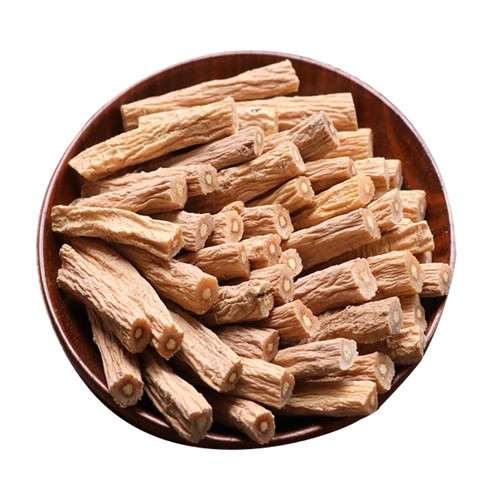Product Overview
Parts used: Dried rhizome
TCM category: Herbs that cool the Blood
TCM nature: Cold
TCM taste(s): Bitter
Meridian affinity: Stomach Large intestine Liver
Scientific name: Scrophularia ningpoensis
Other names: Chinese figwort, Hu Huang Lian
Use of ningpo figwort roots (Xuan Shen) in TCM
Please note that you should never self-prescribe TCM ingredients. A TCM ingredient is almost never eaten on its own but as part of a formula containing several ingredients that act together. Please consult a professional TCM practitionner, they will be best able to guide you.
Preparation: Remove impurities, wash and dry.
Dosage: 9 - 30 grams
Main actions according to TCM*: Expels true or Internal Heat and cools the Blood. Tonifies the Yin. Reduces inflammations and drains Fire toxicity. Reduces hard nodules, especially associated with the lymph.
Primary conditions or symptoms for which ningpo figwort roots may be prescribed by TCM doctors*: Dysentery Jaundice Hemorrhoids Fever Insomnia Constipation Sore throat Boils Carbuncles Goiter
Contraindications*: This herb should not be used by those with Spleen or Stomach Deficiency or Dampness especially when there is diarrhea.
Common TCM formulas in which ningpo figwort roots are used*:
For sore throat and hoarse voice combine ningpo figwort roots with platycodon roots (Jie Geng), liquorice (Gan Cao) and greater burdock fruits (Niu Bang Zi).
For Lung and Kidney Yin Deficiency associated with chronic bronchitis, asthma or chronic pharyngitis combine ningpo figwort roots with lily bulbs (Bai He), prepared rehmannia (Shu Di huang), unprepared rehmannia (Di Huang), dwarf lilyturf roots (Mai Dong), white peony roots (Bai Shao), dong quai (Dang Gui), platycodon roots (Jie Geng), fritillary bulbs (Chuan Bei Mu) and liquorice (Gan Cao).
For treating goiter, swollen and inflamed lymph glands and to soften hard nodules combine ningpo figwort roots with kombu (Kun Bu), sargassum (Hai Zao) and fritillary bulbs (Chuan Bei Mu).
For glandular swellings or cervical or occipital lymphatic swelling combine ningpo figwort roots with oyster shells (Mu Li ke), fritillary bulbs (Chuan Bei Mu) and heal-all spikes (Xia Ku Cao).
For Heat in the Stomach and Heart with painful obstruction of the throat, sores in the tongue, mouth and throat combine ningpo figwort roots with woad leaves (Da Qing Ye), woad roots (Ban Lan Gen), gypsum (Shi Gao), goldthread rhizomes (Huang Lian) and cape jasmine fruits (Zhi Zi).
For Lung Qi deficiency with Heat with symptoms of hoarseness and painful red throat combine ningpo figwort roots with malva nuts (Pang Da Hai).
Key TCM concepts behind ningpo figwort roots (Xuan Shen)'s properties
In Traditional Chinese Medicine (TCM), ningpo figwort roots are plants that belong to the 'Herbs that cool the Blood' category. Herbs in this category are used to clear inflammatory and infectious conditions, referred to as 'Internal Heat' in TCM. This is why most of the herbs in this category will have both antibacterial and antiviral properties. In TCM one has too much 'Heat' in their body as a result of a deficiency of 'Yin' (which is Cold in nature, see our explanation on Yin and Yang) or, more commonly, an excess of Yang (Hot in nature). Herbs that cool the Blood treat the latter and as such tend to be Cold or Neutral in nature.
As suggested by its category ningpo figwort roots are plants that are Cold in nature. This means that ningpo figwort roots typically help people who have too much "heat" in their body. Balance between Yin and Yang is a key health concept in TCM. Those who have too much heat in their body are said to either have a Yang excess (because Yang is Hot in nature) or a Yin deficiency (Yin is Cold in Nature). Depending on your condition ningpo figwort roots can help restore a harmonious balance between Yin and Yang.
Ningpo figwort roots also taste Bitter. The so-called "five elements" theory in Chinese Medicine states that the taste of TCM ingredients is a key determinant of their action in the body. Bitter ingredients like ningpo figwort roots tend to have a cleansing action on the body by clearing heat, drying dampness and promoting elimination via urination or bowel movements.
The tastes of ingredients in TCM also determine what organs and meridians they target. As such ningpo figwort roots are thought to target the Stomach, the Large intestine and the Liver. In TCM the Stomach is responsible for receiving and ripening ingested food and fluids. It is also tasked with descending the digested elements downwards to the Small Intestine. The Large Intestine on the other hand receives the "impure" parts of the digested food from the Small Intestine, absorbs the remaining fluids and excrete the remainder as feces. The Liver is often referred as the body's "general" because it is in charge of regulating the movements of Qi and body fluids. It also takes a leading role in balancing our emotions.








